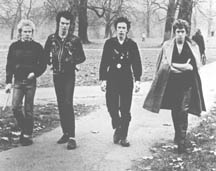Punk Raucous
'Filth and Fury' captures the Pistols firing on all cylinders
By Patrick Reed
The brief, explosive life of the Sex Pistols during the 1970s has continued to serve as an inspiration to those who aspire to unsettle the comfortable inertia of the socio-cultural status quo. Consequently, there has been a continuous amount of attention devoted to the Pistols by fans, journalists, and academics - attention which has, over the years, elevated the story of four downtrodden British yobs and a manipulative manager into a permanent myth of pure and righteous punk rock rebellion.
As anyone who has followed along knows, however, the official "insider's" version of the Pistols' story and its ultimate meaning has been disputed ever since Johnny Rotten threw down his microphone in disgust at San Francisco's Winterland and stalked offstage in 1978.
Manager Malcolm McLaren, who had helped steer much of the Pistols' early direction, has insisted ever since that the Sex Pistols' impact on British (and to a lesser extent, American) society was entirely by his design, and indeed was nothing more than a Great Rock n' Roll Swindle of bored teenagers performed by a master of Situationist-influenced cultural effrontery. Swindle, an alternately sloppy and spellbinding hodgepodge assembled, organized, and released by future music-video innovator Julien Temple in 1980, elevated McLaren's role to that of uber-Svengali and seemed like an unfinished statement.
The Filth and the Fury, directed by Temple with full cooperation from a re-energized Johnny Rotten, serves both as a stinging refutation of McLaren's self-aggrandizement and, thanks to over twenty years of hindsight, an altogether more thorough account of the Pistols phenomenon. Temple mixed clips recycled from both Swindle and Don Letts' seminal Punk Rock Movie (1978) with a staggering array of other imagery to create the visual equivalent of one of Rotten's relentless vocal harangues; the classic Pistols myth of sedition is established quickly and intensified throughout the film, even as Rotten and the rest of the surviving Pistols (guitarist Steve Jones, drummer Paul Cook, and original bassist Glen Matlock) verbally slam the occasional piss out of one another.
Tellingly, there is no mention whatsoever of the Pistols' 1996 reunion tour, viewed by some as a crass sell-out of punk values (for that matter, the members' recent interviews are oddly conducted in silhouette - to conceal male pattern baldness and double chins, perhaps?). Rotten and the rest, instead, muster up a considerable gob of bile for McLaren, whose soundbytes culled from Swindle are presented as pompous puffery in The Filth. This acrimonious approach is consistent with Rotten's legacy of fierce independence, but the "set the record straight" invective becomes repetitive, and seems petty; sworn enemies to the end, Rotten and McLaren, in fact, seem to have more than a bit in common.
The Filth and the Fury covers all of the high points of the Pistols' rise and fall: early rehearsals and concerts, creative publicity stunts, televised uproars by government officials and other horrified elders, and the almost-farcical tour of the American South that culminated in the band's breakup (crackers and Sex Pistols just didn't mix). The infamous, obscenity-laced interview with Bill Grundy on British TV is dissected in-depth (the film's title comes from a resulting tabloid headline). And several of the band's inspirations are glimpsed along the way: Roxy Music, Bowie, the New York Dolls, and Rotten's personal (and intriguing) touchstone, Sir Laurence Olivier's embodiment of Shakespeare's Richard III (1955).
Most impressively, Temple and Rotten place the Pistols' saga within the larger context of British culture and society during the development and stagnation of the postwar welfare state. Clips of TV comedians, the Bay City Rollers, and a promotional short, featuring a chirpy "Up with Britannia" teen group, capture the banality of the era's mass culture, while images of abandoned buildings and historical footage of riots and class conflict set the political and economic tone.
The Sex Pistols may have lit the fuse of an enduring cultural movement, but The Filth and the Fury insists that they were always part of a movement, one that had specific roots in social decay, and that the band existed within this subculture as loud, exciting, and honest broadcasters of the frustration felt by a whole generation of people for whom the promise of British life was truly, "No Future."
Finally, no account of the Pistols' scorched-earth heyday could be complete without a review of the sad, short life of Sid Vicious, the fan-turned-bassist who embodied many of the band's most heinous (and therefore media-attractive) qualities. The Filth obliges: archival interviews with Vicious reveal a semi-intelligent remark or two, but on the other hand, the clips of Vicious and girlfriend Nancy Spungen wasting away together, combined with Rotten's remorseful account of his mate's self-destruction, provide a stark counterpoint to the film's overall endorsement of the Pistols' rebels-with-a-cause legend.n
Note: This film was pulled from this week's Kentucky Theater schedule just prior to press. A listing will appear in Film Flam and Movie Clock when it's rescheduled. Thursday, July 6, will be its final showing at Baxter Ave. Theaters in Louisville.